Moths are an important part of our biodiversity and have vital roles in the environment, providing an essential source of food for many other species of wildlife and acting as important pollinators of flowers. The vast majority of the over 2,500 species found in Britain are beneficial and harmless, but several can be a nuisance and just a few have the potential to be more troublesome.
Moths that can be a nuisance in the home
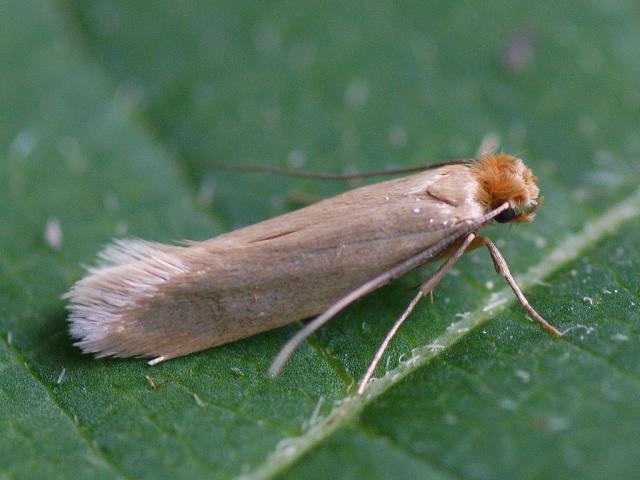
Clothes Moths
There are only two fairly frequent species of clothes moths which cause problems in the home; the Case-bearing Clothes Moth Tinea pellionella and the Common Clothes Moth Tineola bisselliella. These moths are small with a forewing length of between 4 and 8mm. Both sit with their wings tent-like over the body. Case-bearing Clothes Moth has pale greyish brown forewings with one to three darker brown spots and an orangey or reddish brown head. Common Clothes Moth has pale golden forewings with a yellowish or reddish yellow head, and has no darker markings on the wings at all.
It is not the adult moth that causes any damage, but the larval stage. The larva (caterpillar) of the Case-bearing Clothes Moth lives within a portable case as it feeds, while those of Common Clothes Moth feed from within flimsy white silken tubes which can form a mat covering several larvae and can be quite noticeable when seen.
What do they eat?
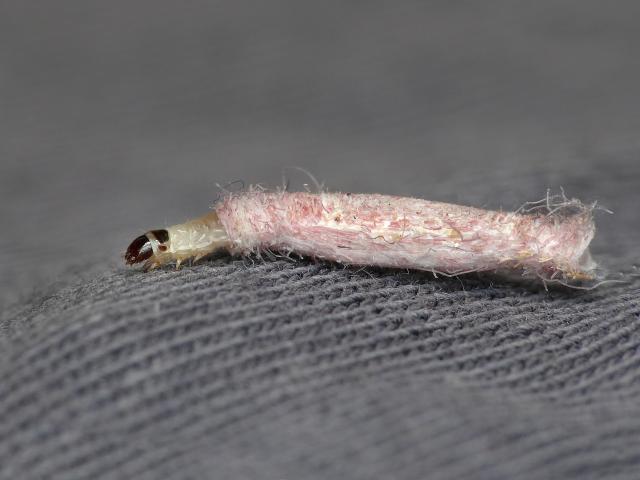
Case-bearing Clothes Moth and Common Clothes Moth both eat fibres of animal origin such as wool, fur and feather. They do not eat cotton and do not eat man-made fibres. The two species prefer slightly different habitats in the home.
Case-bearing Clothes Moth probably evolved in association with bird or animal nests. In the home, it is more likely to infest clothes or carpets which are in dark, slightly humid, dusty and undisturbed places such as under sofas, wardrobes and beds. It is still sometimes found outdoors in birds’ nests and on owl pellets.
Common Clothes Moth is thought to have originated in central or southern Africa, being introduced into Europe around the late 18th century and is now almost cosmopolitan in occurrence. In the home, this species is more tolerant of drier environments and can cope with rooms where the atmosphere is very dry and warm. It is rarely found outdoors in the wild. Indeed a study from Berlin, Germany, showed it to be less frequent away from the city and absent in the countryside. There is likely to be a similar pattern in this country, with this species being more prevalent in cities and larger towns, but largely absent away from these areas. This species has seemingly increased during the 20th century due to central heating systems and drier homes. It is also thought that the Common Clothes Moth is not very good at dispersing and its spread is enabled by the movement of infested items. Both species can still occur within the same building where differing levels of humidity can be found. Results from a recent study indicated that older houses (pre-1950s) may be at higher risk from clothes moths than modern houses as they have more voids, fireplaces, attics etc.
How to reduce the risk of infestation
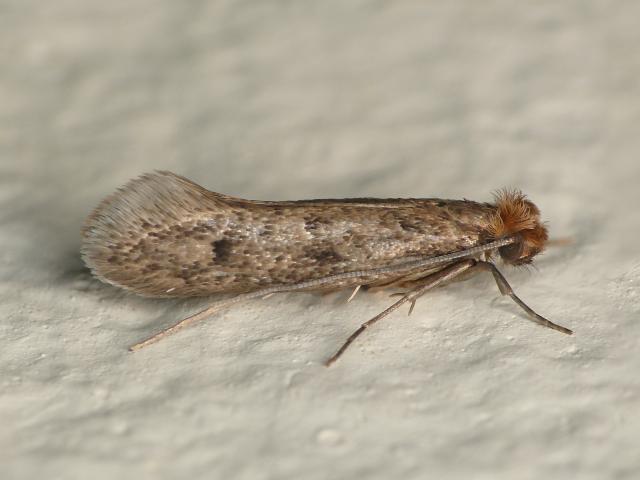
To reduce the risk of infestation it is important to undertake regular checking and cleaning (especially vacuuming). “Spring-cleaning” or deep cleaning of undisturbed places will help deter them. Repellents such as cedar balls or lavender will also help deter the adults. However, once larvae are present, repellants are not effective on larvae.
Clothes that are to be stored for a long time should be placed in sealed vacuum bags (but ensure these have been cleaned prior to storing and are free of clothes moth).
If clothes are attacked, they should be placed in a deep freezer for at least two weeks as this is likely to kill the larvae. If there is further damage in the short term subsequently, then re-freezing for a similar period can help. Large infestations may need advice from a pest control agency.
Other species in the home which are sometimes a nuisance
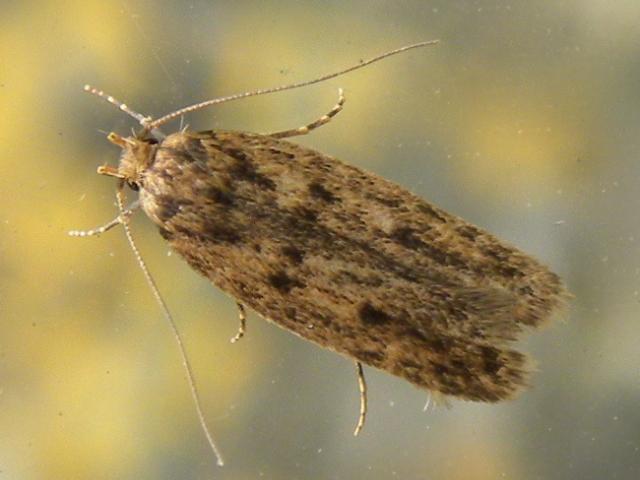
There are a few other species that occasionally can cause problems. As with the clothes moths above, most are quite small, with the largest having a forewing length of c.12mm. Many houses will have these other moths in small numbers and they are rarely a problem in comparison with clothes moths. Those most often seen are Brown House-moth Hoffmannophila pseudospretella and White-shouldered House-moth Endrosis sarcitrella. The larvae of these species feed on a wide variety of dead animal and vegetable matter, with the latter even been found feeding on slug-bait.
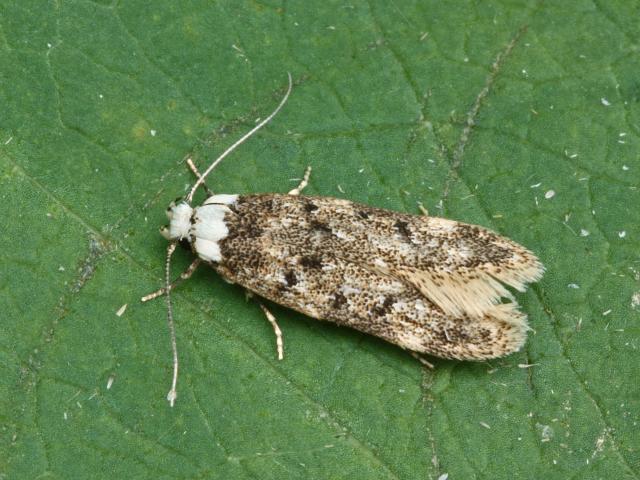
The Tapestry Moth Trichophaga tapetzella was formerly more widespread and sometimes abundant, but it is now very rarely seen. It is associated with animal materials, such as feathers, wool, wasp’s nests etc. with a preference for unheated buildings, stables and outhouses.
Two other species are deserving of mention, these being the Large Pale Clothes Moth Tinea pallescentella and Monopis crocicapitella. The former, whilst widespread in the country is not frequently seen, and can be found indoors and outdoors. It is associated with animal matter, such as fur and wool. The latter species has been found in clothes moth pheromone traps in recent years, although it is not known if this species is being attracted indoors by the pheromone lure as it is typically a species of the outdoors and unheated buildings. It is associated with refuse of plant or animal origin, an occasionally seen in numbers in garden compost heaps.
Larger moths which are a nuisance in some urban areas
Brown-tail
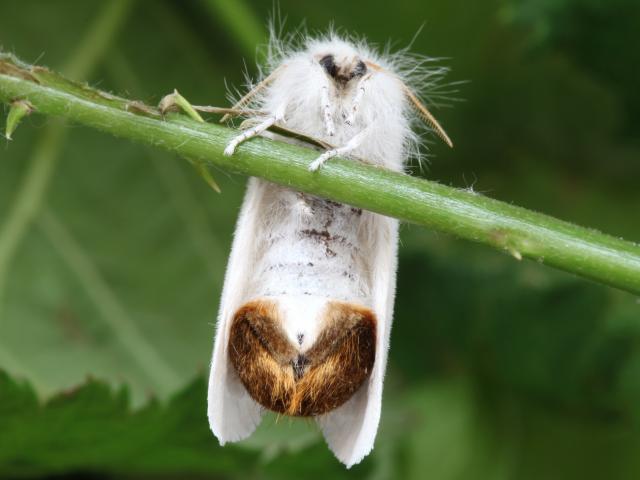
The adult Brown-tail Euproctis chrysorrhoea has silky white wings with a tuft of brown hairs at the end of the abdomen, this more bulbous in the female. The larvae are blackish with brown hairs and white and red spots, reaching over 40mm when fully grown. They overwinter when small, living communally in a tough silken web on the foodplant. They feed on a range of bushes and small trees, particularly favouring bramble Rubus fruticosus, Hawthorn Crateagus monogyna and Blackthorn Prunus spinosa, but can also be found on Dog-rose Rosa canina, oaks Quercus spp. and fruit trees, amongst others. In spring, larvae can be found dispersing away from the nest site.
The larvae and their nests can occur in abundance where found. Both should be avoided where found as the larval hairs, which are also found in the nests, can result in skin irritation and unpleasant rashes. Particularly frequent in coastal localities this moth is moving northwards and is also becoming more frequent inland, with populations found in the London area. Away from the coast, it occurs in open habitats, such as along roadside hedges, parks and in gardens.
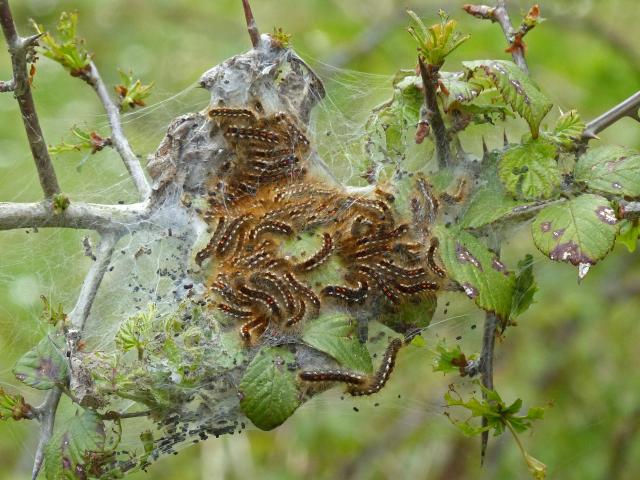
Where numbers have built up and are high, and these are close to human habitation, the local authority should be contacted to deal with any control. Ideally any control should take place over the winter months, involving nest removal. The use of pesticides should be avoided as these are not specific to Brown-tail and could kill non-target species. Also, prior to contacting any local authority, please ensure that the larvae are indeed those of the Brown-tail as other species with hairy larvae, such as the scarce Small Eggar Eriogaster lanestris or the declining Lackey Malacosoma neustria, can form superficially similar nests in the spring.
Oak Processionary
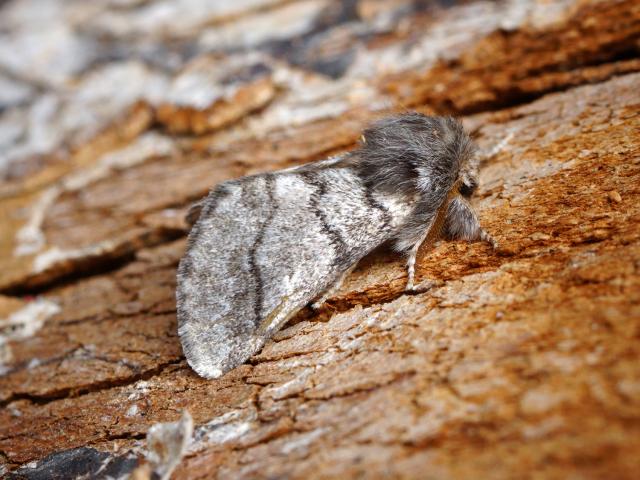
The Oak Processionary moth Thaumetopoea processionea is now well established in the London area and parts of the south-east bordering the capital, and it is continuing to expand its range. As its name implies, it is solely associated with oaks Quercus spp. Although first found as an immigrant in Cornwall in 1983, this species was first recorded breeding in this country in west London in the mid 2000s, this the result of accidental importation through the horticultural trade. Immigrant numbers have increased in recent years, but these are mostly coastal and have all been males.
The larvae can be found from April to June, with the more elusive adult occurring later in the summer. It is the larval stage which can be problematic. Larvae form silken nests on the trunks and branches of trees, sometimes being found low down or even at the base of a tree. The hairy larvae can be seen following each other head-to-tail ‘in procession’ and occasionally can be found in procession on the ground moving from tree to tree. Larval numbers can build and there is the potential for partial defoliation. In mainland Europe there have been cases of complete defoliation, though the trees recover from this unless these defoliation events are repeated year after year.
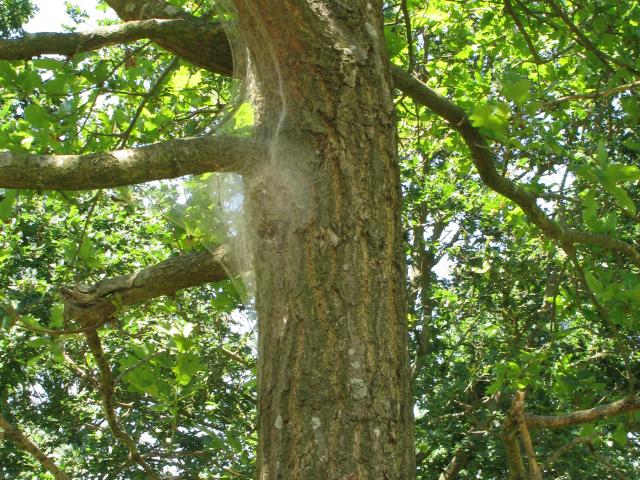
Care should be taken if Oak Processionary moth nests or larvae are encountered and they should be avoided. The hairs of larvae (and those found in the nests) are highly irritant and can result in an unpleasant skin rash, and less often eye irritations or respiratory problems. Regular contact with Oak Processionary can lead to sensitisation. Those working on oak trees or close to trees where the species is known to occur should wear full protective clothing.
pdf 175.91 KB
pdf 222.22 KB
Box Moth
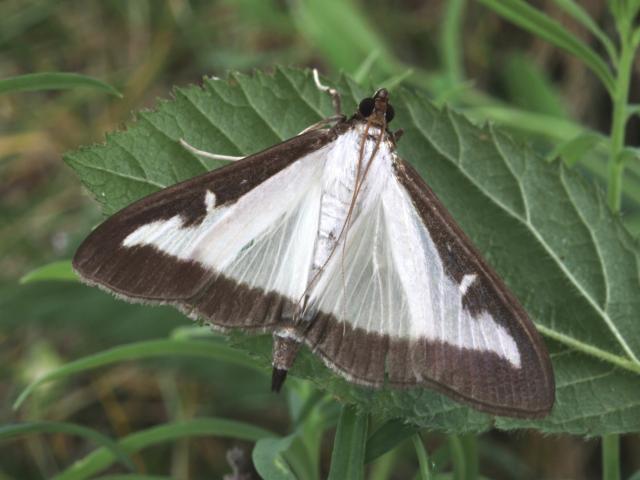
The Box Moth Cydalima perspectalis is a striking moth that was accidentally introduced to the UK originating from south-east Asia. The larvae feed on various species of box Buxus spp. In addition to the form figured there is a melanic variation, the wings being purplish brown with a white spot near the centre of the forewing. The first report of this moth was from Kent in 2007 and by 2011 larvae had been found in private gardens. This species is now well established in the London area, where it is spreading and the population appears to be growing (and is occasionally found in numbers). In recent years it has gained a strong foothold in Essex, Surrey, Hertfordshire and parts of Berkshire. The moth has now been recorded widely over large parts of England, particularly in the south, with the larval stage being found in several widely distributed localities.
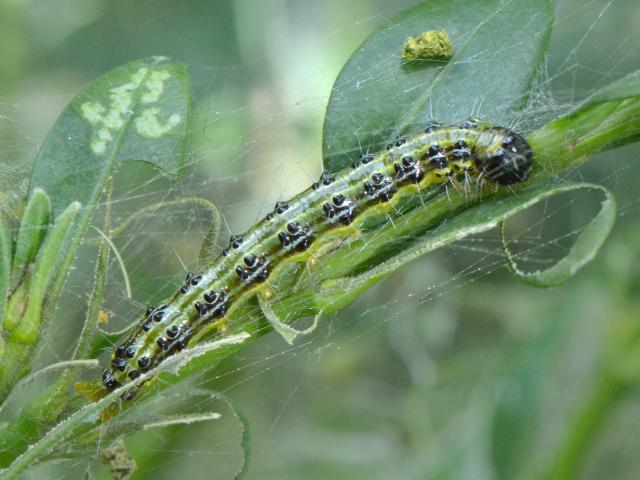
The moth was first reported in Scotland (from Fife) in 2018, it having also been reported from several areas in Wales. There have been increasing reports of the adult moth from coastal localities along southern and south-eastern England, these likely to be primary immigrants from the continent.
Where larval numbers are high it can disfigure ornamental Box hedgerows and topiary, and can defoliate plants completely. The Box Moth is also considered to be a serious pest in parts of Europe on various species of box. In late 2018 Butterfly Conservation updated its advice note on this species.
Horse-chestnut Leaf Miner
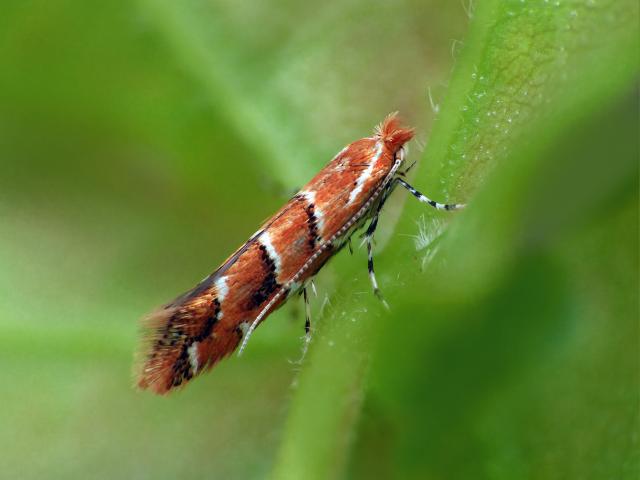
The Horse-chestnut Leaf Miner Cameraria ohridella has spread rapidly in Europe after being first discovered in Macedonia in the mid-1980s. It was first found in Britain in 2002 when it was found in south London. Since that time it has spread rapidly and is now occurs widely over much of England and Wales, and has been noted in Scotland. It is likely that hitching rides on vehicles, trains etc. has aided the dispersal of this species. As the name suggests, it is associated with Horse Chestnut Aesculus hippocastanum, but has also been reported to feed on some other horse chestnut species, Sycamore Acer pseudoplatanus and Norway Maple A. platanoides.
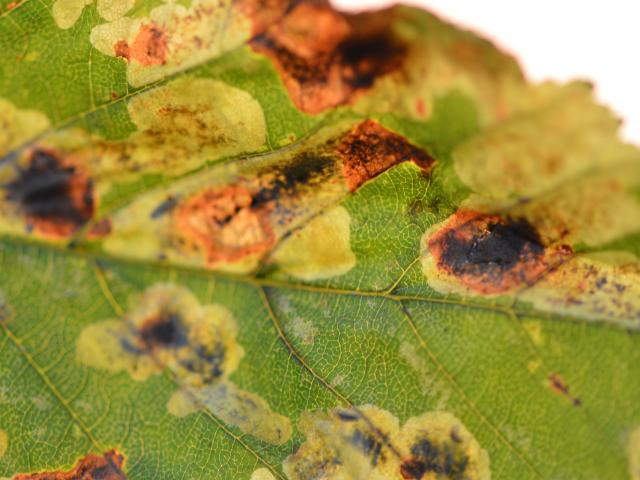
The adult moth is small, with a forewing length of 3.5-5mm and it can occur in large numbers. However, it is the leaf mine of the larval stage which is most noticeable. This species has at least two generations in this country, but it is known to have more in hotter and drier conditions. These leaf mines become more numerous over the summer and can occur in thousands if not tens of thousands, causing the leaves to brown prematurely. Heavy infestations can result in early leaf fall.
Despite these heavy infestations there appears to be no long-term harm to the trees, which produce new leaves the following year, although the growth of young trees may be held back.
Ermine moths:
The ermine moths should not really be considered as troublesome species but could be thought of as a wonder of nature. There are eight species of ermine moths (of the genus Yponomeuta) found in Britain. Most species have white or whitish forewings which are covered in rows of black dots, hence the ermine name. The forewing length ranges from 7.5-13mm.
It is, however, the silken webbing of the larvae which is most frequently seen and can look very alarming. The wispy webs of a few ermine species can be very extensive, completely covering single or even several bushes or shrubs (and sometimes nearby objects such as the base of telegraph poles) giving them a ghostly appearance.
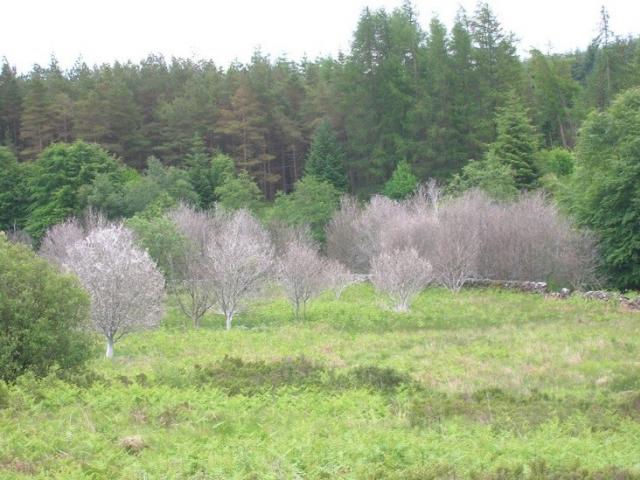
The species that can have particularly extensive webs are the Bird-cherry Ermine Y. evonymella (on Bird-cherry Prunus padus), Orchard Ermine Y. padella (on Blackthorn Prunus spinosa and Hawthorn Crataegus monogyna) and Spindle Ermine Y. cagnagella (on Spindle Euonymus euopaea). These protective webs can harbour vast numbers of larvae which can defoliate the shrubs/bushes. Generally, these will recover and grow new leaves, with the webbing disappearing within a matter of weeks.

